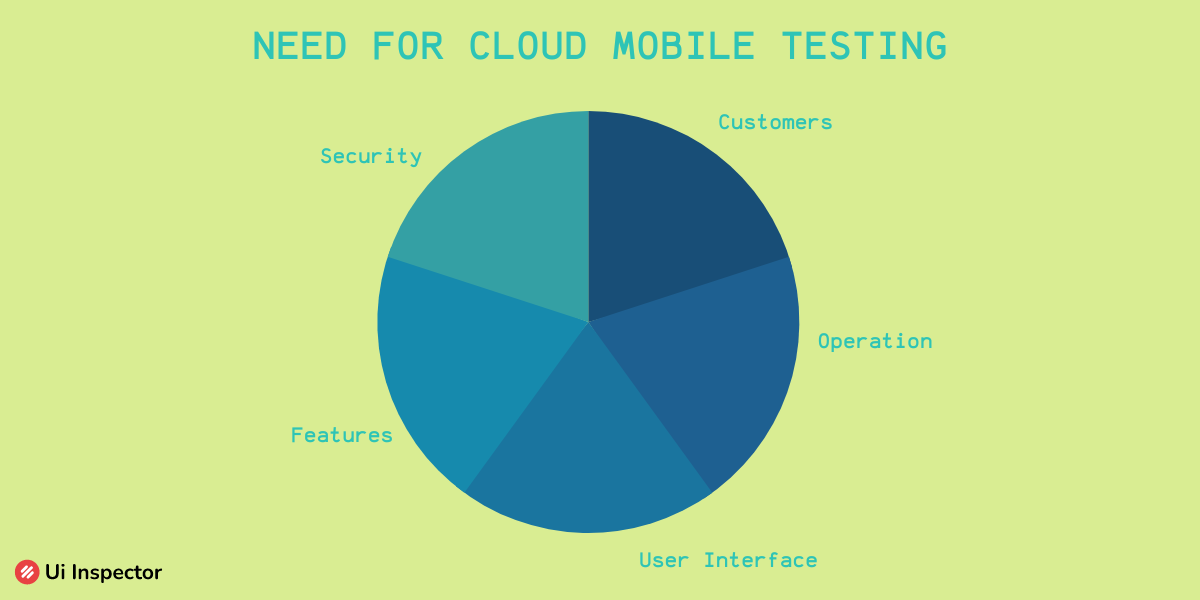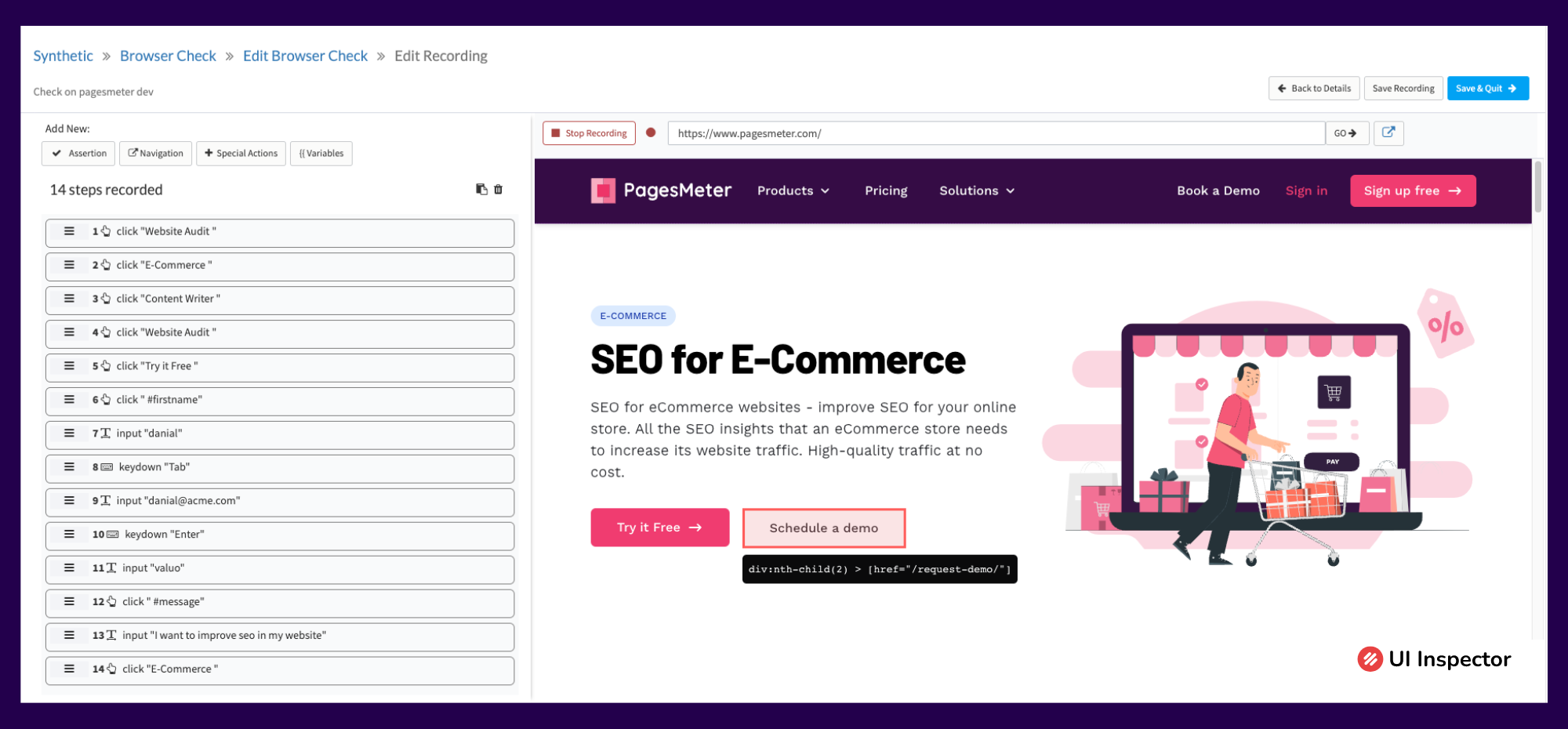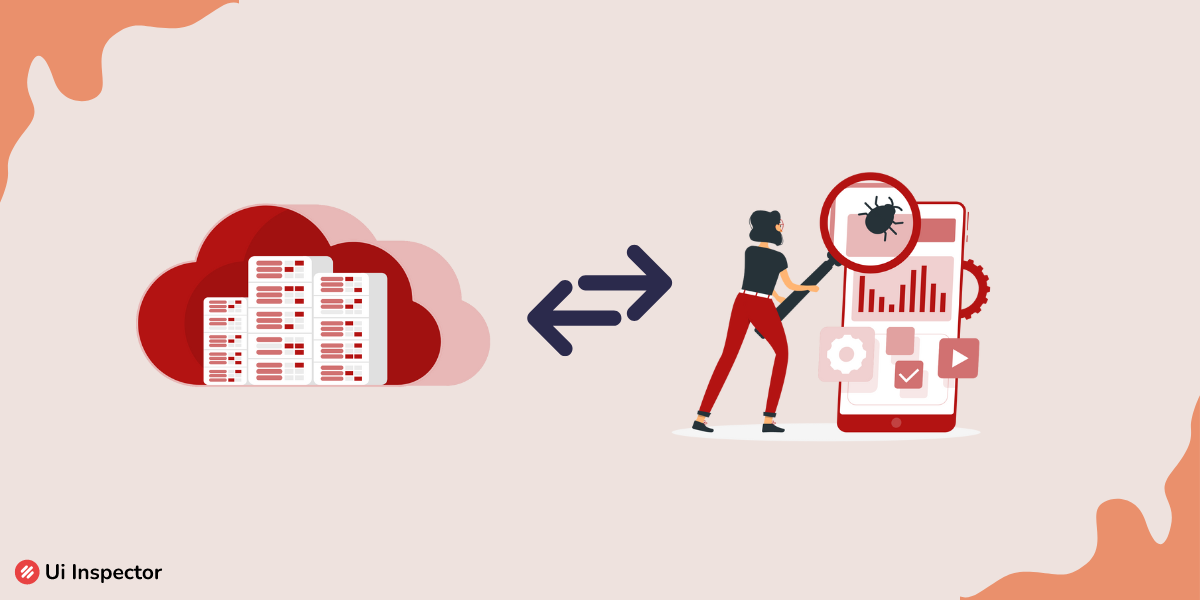A mobile application that is being developed should be compatible with all devices and operating systems. Users can use the application hassle-free on a successful installation without any bugs or viruses.
The number of mobile apps that come out every day is huge. These large numbers have also created more competitors in app development has also raised. So every developer's job is to create an app better than the others.
On that note, any product development needs to have a testing process; there are many ways to do this. Simulators, emulators, and other tools are greatly used for mobile app testing.
Cloud mobile testing is also one such method of testing your mobile application easily. This article will look into all the cloud mobile testing process aspects.
Table of Contents
- Why testing a Mobile Application is so necessary?
- What is Cloud Mobile Testing?
- Setting up the Testing Environment in the Cloud
- Selecting a Cloud Mobile Testing Platform
- Test Case Management in the Cloud
- Running Automated Tests in the Cloud
- Performance Testing In The Cloud
- Integrating Cloud Mobile Testing with CI/CD Pipelines
- Need for Cloud Mobile Testing
- Benefits of Cloud Mobile Testing
Why testing a Mobile Application is so necessary?
Every application or software that is being developed consists of millions of codes. A small error in these codes could disrupt the entire app's functioning and the user experience will be affected a lot.
Frequent testing is to be run on these codes to avoid bugs or errors being present in the application. Only then can the user experience be enhanced and the app's efficiency increases.
As time goes on, any app or software requires certain changes that should be implemented. The changes depend on the preferences of the customers. These preferences can also be tested with the help of testing tools and methods.
What is Cloud Mobile Testing?
Testing of software or app can be done through various tools and processes. Usually, the simpler and faster process is selected over the wide range of methods available in the market. Using a cloud server is one such efficient way.
A cloud server is an unlimited virtual server that is spread across the internet that can be used by any number of users. This server generally stores and shares data along the network with as many people as possible.
Implementing this kind of server with the testing process is highly beneficial for the QA and developers teams.
Cloud mobile testing is also similar to these cloud servers, where the testing is done on a cloud platform, not the premises. Using this testing method, the QA team can easily connect a wide range of devices, versions, operation systems, network carriers, and much more.
This method of mobile testing can integrate various testing processes, like,
- Load test
- UI/UX test
- Latency test
- OS version test
- Phone model test
- Stress test
- Functional test
Setting up the Testing Environment in the Cloud
First, you need to set up your testing environment in the cloud. This involves creating virtual machines or containers that simulate real device configurations, operating systems, and network conditions.
Cloud providers like Amazon Web Services (AWS) or Microsoft Azure offer infrastructure options for hosting your testing environment.
- Select a Cloud Service Provider: Choose a cloud service provider that offers infrastructure and resources suitable for your testing needs. Providers like Amazon Web Services (AWS), Microsoft Azure, or Google Cloud Platform offer options for hosting your testing environment.
- Define Device Configurations: Determine your device configurations to test your mobile app. This includes selecting specific devices, operating systems, screen sizes, and other relevant parameters. Consider the target audience and their device usage patterns to prioritize device configurations.
- Set Up Virtual Machines or Containers: Create virtual machines (VMs) or containers in the cloud to simulate the desired device configurations. VMs provide isolated environments, while containers offer lightweight and scalable alternatives. Provision VMs or containers with the required operating systems and install necessary software dependencies.
- Configure Network Conditions: Test your mobile app under various network conditions by configuring the network settings of the VMs or containers. Simulate different network speeds, latency, and even unstable connections to assess app performance and responsiveness.
- Install Testing Tools and Dependencies: Install the required testing tools, frameworks, and libraries within the testing environment. This may include mobile testing frameworks (such as Appium, Espresso, or XCUITest), SDKs, emulators, simulators, and necessary software dependencies for running automated tests.
- Ensure Scalability and Parallel Execution: Consider the scalability requirements of your testing environment. Cloud providers offer the ability to scale up or down based on demand, allowing you to increase resources when running tests in parallel or on a larger device matrix. This ensures efficient test execution and reduces testing time.
- Security and Data Privacy: Pay attention to security and data privacy considerations. Implement appropriate security measures to protect your testing environment, including secure network configurations and access controls. Ensure any sensitive data used during testing is handled securely and comply with relevant data protection regulations.
- Monitoring and Maintenance: Continuously monitor and maintain the testing environment in the cloud. Regularly update software dependencies, operating systems, and testing tools to ensure compatibility and security. Monitor resource usage to optimize costs and performance.
Selecting a Cloud Mobile Testing Platform
Choose a cloud-based mobile testing platform that provides the necessary tools and features for testing mobile applications.
These platforms offer capabilities such as device farms, real device testing, parallel testing, test reporting, and integrations with popular testing frameworks. Examples of such platforms include AWS Device Farm, Firebase Test Lab, or BrowserStack.
- Define Your Requirements: Start by identifying your specific testing requirements. Consider factors such as target mobile platforms (iOS, Android, etc.), device coverage, test types (functional, performance, security), automation capabilities, reporting and analysis features, development and CI/CD tool integrations, and budgetary constraints.
- Research Available Platforms: Explore the different cloud mobile testing platforms available in the market. Some popular options include AWS Device Farm, Firebase Test Lab, BrowserStack, Sauce Labs, and Perfecto. Evaluate their features, supported devices and operating systems, pricing models, and customer reviews to assess their suitability for your needs.
- Device Coverage: Consider the platform's device coverage and ensure it includes the devices and operating system versions relevant to your target audience. The platform should offer a wide range of real devices, simulators, and emulators for thorough testing across different configurations.
- Automation Support: Assess the platform's support for test automation frameworks and tools. Verify compatibility with popular frameworks such as Appium, Espresso, XCUITest, or XCTest. Check if the platform provides easy integration with your existing automation infrastructure and supports parallel test execution for faster results.
- Reporting and Analysis: Evaluate the platform's reporting and analysis capabilities. Look for features like detailed test reports, logs, screenshots, videos, and performance metrics. The platform should provide insights into test results, helping you identify and debug issues efficiently.
- Integrations: Determine if the platform integrates well with your existing development and CI/CD tools. It should seamlessly integrate with popular tools like Jenkins, GitLab, or Azure DevOps, allowing you to incorporate mobile testing into your existing workflows.
- Support and Documentation: Consider the platform's support channels, documentation, and community resources. Look for prompt, reliable customer support, comprehensive documentation, and active user community or forums. These resources will help you navigate any challenges and make the most of the platform's features.
- Cost and Pricing Model: Evaluate the pricing structure of the platform. Compare the costs based on factors such as the number of devices, concurrency, test minutes, and additional features. Consider your budget and ensure the platform offers a cost-effective solution without compromising on the required features.
- Trial and Evaluation: Whenever possible, take advantage of trial or evaluation periods offered by the platform. This allows you to test the platform's features, performance, and compatibility with your testing requirements before making a commitment.
Test Case Management in the Cloud
Test case management in the cloud involves storing and organizing test cases, test data, and test scripts in a centralized location accessible by the testing team.
Cloud-based test case management tools provide collaboration features, version control, and integration with testing frameworks and automation tools. This ensures efficient test case management and enables teams to track testing progress and results.
- Cloud-based Test Case Management Tools: Choose a cloud-based test case management tool that suits your testing needs. There are several options available, such as TestRail, Zephyr, qTest, or Azure DevOps. These tools provide a centralized repository for test cases, test suites, test data, and associated documentation.
- Centralized Test Case Repository: Create a structured and organized repository within the test case management tool to store your test cases. Categorize and group test cases based on the application's modules, features, or functional areas. This makes locating and managing test cases easier throughout the testing process.
- Test Case Versioning and History: Utilize the versioning capabilities of the test case management tool to maintain a history of changes made to test cases. This allows you to track team members' modifications, updates, and collaboration. It ensures transparency and facilitates effective communication during the test case lifecycle.
- Test Case Traceability: Establish traceability links between test cases, requirements, and other related artifacts. Connect test cases to the corresponding user stories, functional requirements, or design specifications. This helps ensure that all aspects of the application are adequately covered by test cases and enables better requirement coverage analysis.
- Collaboration and User Roles: Enable collaboration by providing different user roles and permissions within the test case management tool. Assign roles such as test case authors, reviewers, or approvers to facilitate a smooth workflow. Encourage team members to contribute, review, and provide feedback on test cases.
- Integration with Testing Tools: Integrate the test case management tool with other testing tools and frameworks, such as test automation tools or defect tracking systems. This streamlines the testing process and allows for seamless test results, automation status, and defect information transfer.
- Test Execution and Reporting: Record the execution status and results of test cases within the test case management tool. Update the test case status as tests are executed, and record any defects or issues encountered during testing. Generate reports and metrics to analyze test coverage, execution progress, and quality metrics.
- Real-time Collaboration and Visibility: Leverage the cloud-based nature of the test case management tool to enable real-time collaboration and visibility across team members. Multiple users can access and work on test cases simultaneously, facilitating efficient teamwork and ensuring everyone stays updated with the latest changes.
- Security and Access Control: Pay attention to security measures and access control within the cloud-based test case management tool. Implement appropriate authentication, authorization, and data encryption protocols to safeguard your test case repository.
Running Automated Tests in the Cloud
You can run automated tests in the cloud with the testing environment set up and the mobile testing platform selected.
Write or import your test scripts into the chosen automation framework (such as Appium, Espresso, or XCUITest) and execute them against virtual or real devices available in the cloud. The cloud platform provides the necessary infrastructure to execute tests in parallel, reducing testing time and increasing efficiency.
- Select a Cloud Testing Platform: Choose a cloud-based testing platform that supports the execution of automated tests. Popular options include AWS Device Farm, Firebase Test Lab, Sauce Labs, BrowserStack, or Perfecto. These platforms provide a wide range of devices, operating systems, and testing capabilities.
- Test Script Preparation: Prepare your automated test scripts using your preferred test automation framework (such as Selenium, Appium, or Cypress). Ensure that the test scripts are compatible with the target devices and operating systems supported by the cloud testing platform.
- Configure Test Execution: Set up the necessary configurations in the cloud testing platform to specify the devices, operating systems, and other testing parameters for executing your automated tests. Configure any required test data or environment variables.
- Upload Test Artifacts: Upload your test scripts, application builds, test data files, and any other required test artifacts to the cloud testing platform. This ensures that all necessary components are available for the test execution.
- Test Execution Environment: Select the desired execution environment within the cloud testing platform. This could involve choosing specific device configurations, network conditions, or other relevant settings to replicate real-world scenarios.
- Test Execution Triggers: Initiate the test execution manually or through your continuous integration/continuous delivery (CI/CD) pipeline. Cloud testing platforms often provide APIs or plugins that enable seamless integration with popular CI/CD tools like Jenkins, Travis CI, or Azure DevOps.
- Monitor and Analyze Test Execution: Monitor the progress of test execution through the cloud testing platform's interface. Track the status of test runs, view logs, capture screenshots or videos of the tests, and identify any failures or issues encountered during the execution.
- Test Result Analysis and Reporting: After completing the tests, analyze the test results and generate reports. Cloud testing platforms offer comprehensive reports that provide insights into test coverage, pass/fail status, performance metrics, and other relevant data. Use these reports to identify defects, bottlenecks, and areas for improvement.
- Integration with Defect Tracking and Collaboration Tools: Integrate the cloud testing platform with your defect tracking system or collaboration tools to seamlessly transfer test results, log defects, and enable effective communication between testers and developers.
Performance Testing In The Cloud
It allows organizations to assess the performance and scalability of their applications while gaining immediate insights into performance metrics. By this, organizations gain real-time visibility into the performance of their applications.
This enables timely identification of performance issues, faster root cause analysis, and iterative optimization. The integration with CI/CD pipelines ensures that performance is a critical aspect of the continuous delivery process.
- Setting up the Performance Testing Environment in the Cloud: Configure the testing environment in the cloud, leveraging the scalability and elasticity of cloud resources. This involves creating virtual machines or containers that replicate real-world configurations and network conditions.
- Define Performance Metrics and Thresholds: Determine the performance metrics to be measured, such as response time, throughput, and error rate. Set thresholds for each metric to define acceptable performance levels. These metrics will be used for real-time monitoring and reporting.
- Load Generation and Scalability: Utilize load testing tools or cloud-based load testing services to generate simulated user loads on the application. Scale resources in the cloud environment dynamically to simulate varying loads and assess the application's scalability.
- Real-time Monitoring: Implement real-time monitoring tools to collect performance metrics during the load test execution. Monitor CPU usage, memory utilization, network traffic, and response times. This provides immediate visibility into the application's performance as the test is ongoing.
- Threshold Alerts and Notifications: Configure threshold alerts within the monitoring tools to trigger notifications when performance metrics exceed predefined thresholds. These alerts enable real-time identification of performance bottlenecks and immediate attention to potential issues.
- Continuous Reporting and Analysis: Continuously analyze the performance metrics collected during the load test. Generate real-time reports summarizing the current performance status, trends, and deviations from expected values. These reports aid in identifying performance issues promptly.
- Root Cause Analysis: Utilize real-time monitoring data and performance reports for root cause analysis. Investigate any performance bottlenecks or anomalies and determine the underlying causes. This analysis helps in making informed optimizations and improvements.
- Feedback and Optimization: Use real-time monitoring and reporting to provide immediate feedback to the development team. Collaborate to address performance issues and optimize the application. Iterate on the performance testing and monitoring process based on the insights gained.
Integrating Cloud Mobile Testing with CI/CD Pipelines
Integrating cloud mobile testing with CI/CD pipelines enables seamless and automated testing as part of the continuous integration and delivery process. By this, you can automate mobile testing processes, ensure consistent quality checks, and accelerate the delivery of mobile applications. This integration promotes faster feedback and early bug detection and enhances the overall efficiency of the software development lifecycle.
Here are the steps involved:
- Choose a cloud-based mobile testing platform that aligns with your CI/CD pipeline requirements. Consider factors such as device coverage, automation capabilities, and integration options. Popular platforms include AWS Device Farm, Firebase Test Lab, BrowserStack, and Sauce Labs.
- Integrate the chosen mobile testing platform with your test automation framework. Most cloud testing platforms support popular frameworks like Appium, Espresso, XCUITest, or XCTest. This integration allows you to execute automated mobile tests directly from your CI/CD pipeline.
- Determine the appropriate stage within your CI/CD pipeline to trigger the execution of mobile tests. Common stages for mobile testing include pre-deployment testing, post-deployment testing, or as a separate dedicated test stage.
- Set up the necessary configuration to provision the required mobile devices or emulators within the cloud testing platform. Define the specific device configurations, operating systems, and network conditions that align with your testing requirements.
- Configure the parameters for test execution, such as the test suite to be executed, test data, and any additional settings specific to your application. This configuration ensures that the appropriate tests are executed on the defined mobile devices or emulators.
- Within your CI/CD pipeline, trigger the execution of mobile tests using the integration with the cloud testing platform. This can be done by invoking the appropriate commands or APIs provided by the platform and passing the required test configuration and test suite information.
- Once the mobile tests are executed, collect the test results and associated artifacts from the cloud testing platform. This includes logs, screenshots, videos, and any performance metrics captured during the test execution.
- Analyze the test results to identify any failures or issues encountered during testing. Generate reports summarizing the test execution status, pass/fail results, and any associated defects or performance bottlenecks. These reports provide insights into the quality of the mobile application.
- Integrate the cloud mobile testing platform with your defect tracking system or collaboration tools. This enables the automatic creation of defects or issues and facilitates seamless communication between testers and developers.
- Use the test results to determine whether the application is ready for deployment or requires further improvements. Based on the test outcomes, decide whether to proceed with deployment or trigger a feedback loop to address any identified issues.
Need for Cloud Mobile Testing
There are many other ways and platforms through which the testing of an application can be carried out. Nonetheless, we should ask ourselves why we need this cloud-based testing for mobile devices.
Using cloud technology for mobile testing could be costly, but it is always best to use this testing method in certain situations.

1. Customers
Before implementing cloud servers, the number and type of customers should be analyzed. A mobile application can be used by a larger crowd and also by a small organization or company.
When the app's functions are so critical and specific for a smaller population, cloud technology can be used to test the mobile application.
2. Operation
This is based on the company’s requirements. Cloud platforms are unnecessary if the application is web-based because the internet consists of all testing tools, which are easier than cloud technology.
3. User Interface (UI)
The cloud mobile testing method is implemented when apps don’t have a fully created UI or lack a highly sophisticated UI design. This is hard to carry out testing on-premises, so cloud testing is recommended.
4. Features
For any app or software, the features need to be changed based on the requirements of the users. But there are certain conditions when the features are changed frequently, so testing needs to be done in a shorter time.
Cloud technology is not recommended for applications where the features are often changed because the app design is unstable. So it is better to choose other testing platforms.
5. Security
When the app contains vital information about the company or organization, cloud technology is not used for testing. This is because cloud servers are easily accessible, and many people can access your data.
Benefits of Cloud Mobile Testing
Tests on apps developed with cloud technology have some advantages over other testing methods. The QA team also highly benefitted through this testing process.
1. Availability
Cloud servers are always available, and it is easy for the QA team to access the files and data whenever they want. The availability of the cloud is not restricted to any time zone or location, it can be used anytime without any trouble.
The team can perform the testing procedures even while traveling or connect with members worldwide to complete the testing process because the cloud servers are easily available anywhere and at any time.
2. Scalability
The data that can be stored in the cloud has no limit. The information can be easily scalable and anyone with cloud access can enter their information so that this can be viewed by the team lead and other members.
Multiple devices can be connected to the cloud at a single time and testing can be done simultaneously. Even though multiple devices are connected, the quality of tests remains the same for all.
3. Productivity
Using cloud technology saves time and increases the productivity of your company. Since multiple testing processes are combined and performed together productivity is greatly improved.
Not just that, using cloud technology makes it easier for the team member to store the data simultaneously. No additional feature is required to store or monitor the information that is gathered during testing.
4. Cost
Acquiring cloud software could be expensive, but when thinking about future processes and tests it is better to have cloud technology. The use of cloud technology combines many other tests that need to be done in a mobile application.
This reduces the cost of other testing processes and methods. The cost needed to buy testers and software is also reduced when the cloud testing method is being used.
5. Maintenance
Cloud servers are the easiest testing tools to maintain. These servers are not complex devices that should be often checked and monitored for repairs or bugs. The maintenance costs are not required when cloud technology is implemented in your organization.
Conclusion
Testing an application is a long process and requires great attention. Even missing out on a small detail can lead to hazardous threats in the application due to bugs, viruses, errors, dead links, and so on.
Due to these reasons, the testing of an application holds a significant place. Various tools and methods can be implemented to carry out these testing processes. Choosing these methods entirely depends on the requirements of the company.
Out of all the methods and tools, cloud mobile testing is considered to be highly beneficial due to its advantages such as cost-efficient, increased efficiency, company productivity, and so on. So analyze your company’s requirements and choose the testing methods that are best suited for your organization.
Simplify Testing and Enhance Application Quality
Ui Inspector is a comprehensive testing tool designed to streamline the testing process and elevate the quality of your applications. With its wide range of powerful features, UI Inspector empowers developers and QA teams to efficiently tackle common testing challenges.

Ensure seamless functionality and consistent user experience across multiple browsers. Identify and resolve API issues early in the development process, to reduce the risk of costly failures in production.
Minimize critical bugs that occur in production, and save time, effort, and resources by reducing post-release bug fixes and patches.
Sign up now for UI Inspector's 14-day free trial offer and experience the power of its features to discover limitless possibilities!


